Born in France. Designed in Milan. Produced in Nepal. This is the motto, and the beauty, of cc-tapis. Today I sit down with founder Fabrizio Cantoni and art director Daniele Lora at Inform Interiors, and learn about the production behind their gorgeous handmade rugs. It is true when they say that stimulation comes in many forms. Today, it comes from the best of three worlds: storytelling, a pursuit of passion, and a collaboration between people with vision.
Tell me about the start of cc-tapis.
Fabrizio Cantoni: I started as a rug shop in Strasbourg. That is where I used to sit in my shop to imagine designs and sell them in my store. My wife decided that Strasbourg was too calm for our brand to grow, so we moved to Milan (I always follow what my wife says). There, I did a master course in interior design, and that’s where I met Daniele. We were school buds from seven years ago. We started working on projects during the master course, and he was crazy enough to follow this adventure. We branded and built cc-tapis together. Today we have three associates: my wife, myself, and Daniele.
When we started, everything was designed in-house. We didn’t work with outside people and we created out of our own self-expression. Back then, everyone was doing scratched rugs, but we were already into patterns, and designs inspired by historical events. For example, one rug was inspired by a mosaic pavement in Pompeii. Another, a flooring in a church in Naples, or works by the great Italian design masters. We rework these inspirations to make it our own. That is how we started. After that, it became natural for us to open up and interpret other people’s sensitivity through our rugs. Their vision became our vision.
What is the story you want to tell through your rugs?
Daniele Lora: The main idea is that our rug has a soul. We don’t do machine-made, tufted rugs. Each rug is knotted by hand with a production time that lasts months. There are no acids, no chemicals. Every rug tells a story of production and an ancient craft.
FC: To complete what Daniele is saying, we are not the only people who produce rugs. The great work that Daniele is doing is that he really looks for coherence in the language of the rugs. I like to think that when you see a cc-tapis rug, you recognize it as being a cc-tapis rug. That is because everyone we work with is an architect. The rug is not treated like a mere decoration—it is treated like a project and always has a meaning.
How would you describe cc-tapis in a few words or sentences?
FC: This is a tough one [laughs]. There are so many different aspects to what we do. I think it resumes to our motto of: “Born in France. Designed in Milan. Produced in Nepal.” We are proud of where we produce; the quality; being Italian. Our decorative approach. I wouldn’t know how to summarize the work we do.
DL: To discover ourselves is important. To continue to be curious. We are not recognized for a style. We are not minimalists. We are maximalists. We are our own vision that was discovered in many ways. We went from decorative with Patricia Urquiola to Faye Toogood, who is very avant-garde. We discover the shape, the finishing in materials. Everything is about the finishing, and we are lucky enough to be able to discover everything we like. Our vision is to take someone’s vision and make it our own. We interpret worlds through our rugs.

Tell me the story behind Inventory, your new collaboration with Faye Toogood that is on display at Inform.
FC: Our exhibition with Faye is a curious one. We flew to London. We met Faye in person. She showed us her sample library and took out bits and pieces of wood and twigs. Then she sat down at her sewing machine and sewed two patterns. It was basically Faye opening up her world to us. After that, we flew from London to Kathmandu with a suitcase full of bits and pieces of twigs. Once we got to Kathmandu, we sat down in our office for three days and worked on transforming Faye’s world into cc-tapis rugs. That was a super experience, and it is what makes me vibrate. We interpreted Faye’s world through knotting and stitching in a way that made her very, very happy.
We translated her vision into five rugs. I really see Faye in the rugs and set-up we made—the imperfections, the shape, and details. We want people to understand her world when they walk through the exhibition.
What is it about Nepal that captivates or inspires your work at cc-tapis?
FC: Nepal is important to us. The people we work with. The Tibetans. They are kind and very easy-going people. Our associate is a very curious person. He never takes no for an answer and always responds with, “Yes, let’s find a way to create this.” Our work in Nepal is structured so that we can do everything in-house. We buy yarn, we colour it, we finish and ship them all under one roof. That is the way we like it and that is what allows us to innovate on the foundation with respect to this ancient craft.
Socially, my wife fell in love with the local population, so we created cc-for education. It is our nonprofit organization where we send the children of our weavers to school. A part of what we make is given to cc-for education. It is our way to give something back.
Can you share a little about the process behind making the rugs?
DL: First of all, we start with sharing ideas with our designers. It is not about technical drawings. Just ideas. We chat a lot. We share lots of pictures and ideas and approaches. After that, we use our rug-creating techniques to create rugs from those ideas.
FC: When we work with designers, we very rarely give briefs—we don’t want to give them direction. We leave them free to come up with ideas; if it’s appealing, we take it and imagine our rugs with the designer.
What do you look forward to in the next few years at cc-tapis?
FC: If we can continue like where we are now that would be perfect. We are having a lot of fun. I take pleasure in going to work every morning. I meet great people—young designers, and the retailers such as Nancy Bendtsen at Inform. They are people who understand what we make. I don’t want to become the king of the world, but I would like for cc-tapis to be recognized internationally for what it is, and for that to not change.
This interview has been edited and condensed for clarity.
Read more in Design.














